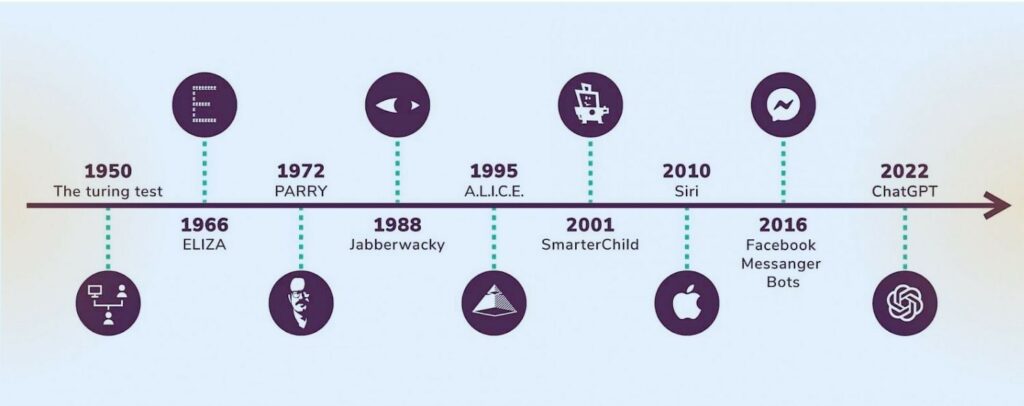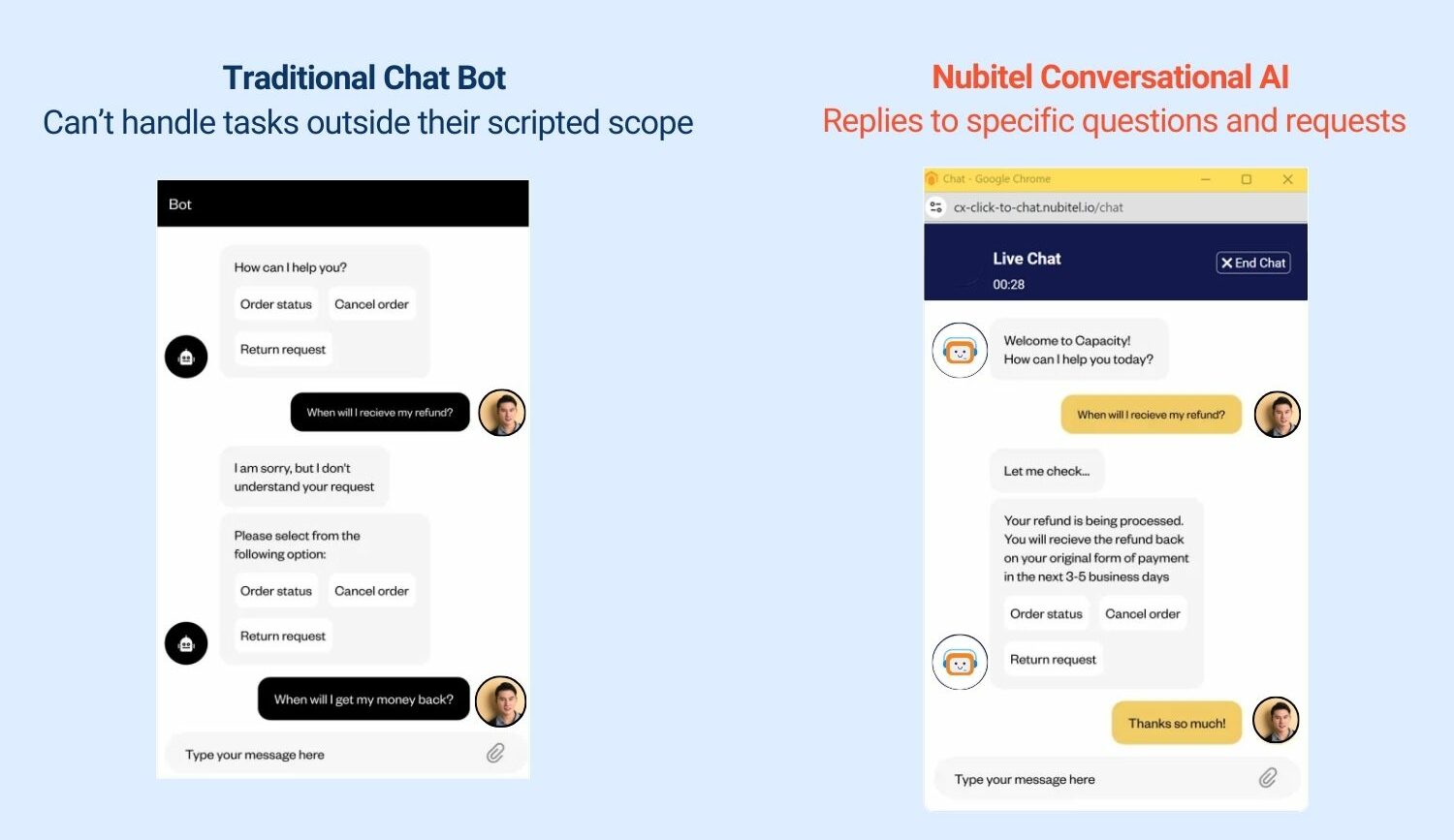The way businesses communicate with customers has undergone a digital transformation. Chatbots and Conversational AI represent two key innovations in this space, often used interchangeably but with significant differences. While chatbots excel at handling basic, rule-based interactions, Conversational AI takes customer engagement to the next level with context-aware, human-like conversations. This article demystifies these technologies, highlighting their distinctions, use cases, and benefits.
Table of Contents
ToggleWhat are Chatbots?
Chatbots are computer programs designed to simulate human interaction through text or voice interfaces. These systems are typically rule-based, following predefined scripts to deliver automated responses to common queries.
The evolution of chatbots began with ELIZA in the 1960s, which mimicked simple human conversations using predefined responses. Over time, they advanced to become vital tools for businesses, addressing FAQs and streamlining customer service operations. Today, chatbots remain an affordable solution for businesses seeking basic automation.

Chatbots are ideal for straightforward tasks like providing store hours, troubleshooting guides, or offering step-by-step navigation on websites. However, their linear approach and inability to adapt to complex or nuanced queries restrict their versatility in dynamic customer interactions.
What is Conversational AI?
Conversational Artificial Intelligence (AI) is a suite of technologies, including natural language processing (NLP), machine learning, and deep learning, that enables machines to engage in intelligent, human-like conversations. These systems are designed to understand, process, and respond to text or voice inputs with remarkable accuracy.
It processes vast datasets to learn human language patterns, enabling it to comprehend context and user intent. This capability allows it to provide adaptive, personalized responses across multiple communication channels, including text, voice and even video.
According to Marketsand Markets™, the global Conversational AI market is projected to grow from USD 13.2 billion in 2024 to USD 49.9 billion by 2030, driven by increasing adoption across industries like healthcare, e-commerce, and financial services.
Chatbots vs. Conversational AI: Key Differences
Understanding what sets Conversational AI apart from chatbots is crucial for businesses aiming to choose the right solution for their customer engagement needs. While both technologies aim to enhance communication, they differ significantly in complexity, functionality, and capabilities.
The table below provides a clear comparison of their key attributes:
| Feature | Chatbots | Conversational AI |
| Definition | Automated systems for predefined tasks | AI-driven systems for intelligent, adaptive conversations |
| Type of Input | Text-based | Text, voice, and video |
| Operation | Rule-based | Machine learning-powered |
| Interactivity | Linear, limited understanding | Nonlinear, contextual understanding |
| Channels | Single channel | Omnichannel |
| Scalability | Manual scaling required | Self-learning and scalable |
| Multilingual Capabilities | Limited | Supports multiple languages |
| Adaptability | Fixed responses | Dynamic and personalized responses |
Chatbot Use Cases in Customer Service
- Basic FAQs : Chatbots effectively handle routine inquiries such as business hours, return policies, or troubleshooting guides. For example, a retail chatbot might instantly provide return policy details to customers.
- Appointment Scheduling: Businesses in healthcare or salons can utilize chatbots to automate appointment bookings, offering real-time availability without the need for manual intervention.
- Order Status Updates: E-commerce platforms benefit from chatbots that provide live updates on order tracking, enhancing customer satisfaction without burdening customer service agents.
- Automated Support: Chatbots address simple issues like password resets or account information updates, freeing human agents for complex tasks.
Conversational AI Use Cases in Customer Service
- Personalized Product Recommendations
Conversational AI can analyze a customer’s preferences and recommend products, like suggesting vacation packages based on previous searches.
- Complex Issue Resolution
By understanding context, Conversational AI efficiently resolves multifaceted problems such as billing discrepancies or advanced troubleshooting.
- Natural Language Understanding
It comprehends informal or ambiguous language, making it highly reliable in conversations that demand precision and personalization.
- Emotional Support and Empathy
Conversational AI detects emotional cues and adapts responses to provide comfort, useful in industries like healthcare or customer care.
Benefits of Conversational AI Over Traditional Chatbots
The future of customer engagement is being reshaped by the rapid advancements in AI-powered solutions. According to Gartner, by 2028, 70% of customer service journeys will begin and be resolved within conversational, third-party assistants integrated into mobile devices. This shift reflects the growing demand for seamless, on-the-go interactions that are both efficient and personalized.
Let’s explore how Conversational AI outshines traditional chatbots in delivering seamless, human-like experiences with its advanced features:
1. Advanced Natural Language Understanding
Conversational AI leverages natural language processing (NLP) to interpret complex and ambiguous user queries with precision. Unlike traditional chatbots, which rely on rigid rules, Conversational AI understands context, slang, and even emotional undertones. For instance, a banking AI assistant can accurately process questions like, “What’s the safest way to invest my savings?” and provide relevant advice.
2. Contextual Maturity
Conversational AI remembers past interactions, enabling continuity in customer conversations. This contextual awareness allows businesses to deliver personalized experiences, such as following up on unresolved issues or recommending products based on a user’s history. Traditional chatbots, in contrast, lack memory and cannot adapt to ongoing dialogues.
3. Multi-Intent Cognition
While chatbots struggle to handle multiple requests in a single query, Conversational AI seamlessly addresses multi-intent conversations. For example, a customer asking, “What’s my account balance, and can I transfer $100 to savings?” receives an accurate, cohesive response in one interaction.
4. Integration, Scalability, Accuracy, and Consistency
Conversational AI integrates easily with existing systems, from CRMs to customer support platforms, ensuring smooth workflows. Its scalability allows businesses to manage increasing demands without manual adjustments, delivering accurate and consistent responses regardless of the volume or complexity of queries.
5. Multilingual Capabilities and Voice Assistance
Supporting multiple languages and voice commands, Conversational AI breaks language barriers, enabling businesses to engage a global audience. This is particularly valuable for industries like travel and hospitality, where customers often prefer native-language interactions.
Conversational AI vs. Chatbots: Which is Best for Your Business?
Choosing between chatbots and Conversational AI requires a thoughtful assessment of your business’s needs.
Traditional Chatbots:
- Cost-effective for automating basic queries.
- Best suited for small businesses or those with limited technical resources.
Conversational AI:
- Ideal for organizations prioritizing scalability, personalized experiences, and innovation.
- Suitable for industries with high customer engagement requirements, such as finance, healthcare, and e-commerce.

Take the Next Step with Nubitel’s Conversational AI
Aligning your choice with business goals is critical. If your focus is on efficiency and cost reduction, traditional chatbots are a practical choice. However, if you aim to deliver human-like interactions and future-proof your operations, Conversational AI is a strategic investment. This technology not only meets today’s demands but also adapts to evolving trends, ensuring your business remains competitive in the digital era.
Ready to elevate your customer engagement strategy? Discover how Nubitel Conversational AI can transform your business with personalized, scalable, and innovative solutions. Learn more about Nubitel Conversational AI and stay ahead in the ever-evolving digital landscape.





